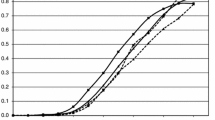Abstract
Using data front 2522 young men who were first surveyed as 7th-grade students in Houston, Texas in 1971, we examined the psychological consequences in early adulthood of having a girlfriend become pregnant in adolescence. By age 21, 15% of the young men were involved in a nonmarital pregnancy. Rates were higher for blacks (24%) than for whites (12%) or Hispanics (16%). Among whites, most adolescent pregnancies were ended by abortion (58%). Adolescent pregnancies to blacks most often resulted in single parenthood (56%). Hispanics tended to have the child, and marry or live together (55%). Consistent with the life course perspective, young men involved in adolescent pregnancies were more psychologically distressed as young adults than those who did not have a girlfriend become pregnant in adolescence. The greater distress in adulthood is not simply a function of accelerated role transitions, because men whose girlfriends had abortions are also distressed, and those who let their girlfriends assume major parenting responsibility are no less distressed than those who became fathers and married or lived with their girlfriends. Subgroup comparisons revealed that psychological distress levels of young black men were not influenced by adolescent pregnancy.
Similar content being viewed by others
References
Bacon, L. (1974). Early motherhood, accelerated role transition, and social pathologies.Social Forces 52: 333–341.
Becerra, R. M., and de Anda, D. (1984). Pregnancy and motherhood among Mexican American adolescents.Health Social Work 9: 106–123.
Bracken, M. B., Hachamovitch, M. and Grosman, G. (1974). The decision to abort and psychological sequelae.J. Nerv. Mental Dis. 158: 154–162.
Brown, H., Adams, R. G., and Kellman, S. G. (1981). A longitudinal study of teenage motherhood and symptoms of distress: The Woodlawn Community Epidemiology Project. In Simmons, R. G. (ed.),Research in Community Mental Health: A Research Annual (Vol. 2). JAI Press, Greenwich, CT.
Bumpass, L. L., Rindfuss, R. R., and Janosik, R. B. (1978). Age and marital status at first birth and the pace of subsequent fertility.Demography 15: 75–86.
Card, J. J., and Wise, L. L. (1978). Teenage mothers and teenage fathers: The impact of early childbearing on the parents' personal and professional lives.Family Plan. Perspect. 10: 199–205.
Cazenave, N. A. (1981). Black men in America: The quest for manhood. In McAdoo, H. P. (ed.),Black Families. Sage, Beverly Hills, CA.
Chilman, C. S. (1980). Social and psychological research concerning adolescent childbearing: 1970–1980.J. Marriage Family 42: 793–805.
Elster, A., and Hendricks, L. E. (1986). Stresses and coping strategies of adolescent fathers. In Elster, A., and Lamb, A. (eds.),Adolescent Fatherhood. Erlbaum, Hillsdale, NJ.
Elster, A. and Panzarine, S. (1983). Teenage fathers: Stresses during gestation and early parenthood.Clin. Pediat. 22: 700–703.
Freeman, E. W. (1978). Abortion: Subjective attitudes and feelings.Family Plan. Perspect. 10: 150–155.
Friedman, C. M. (1972). Unwed motherhood: A continuing problem.Am. J. Psychiatr. 129: 85–89.
Glick, P. C. (1981). A demographic picture of black families. InBlack Families, McAdoo, H. P. (ed.). Sage, Beverly Hills, CA.
Hofferth, S. (1984). Kin networks, race, and family structure.J. Marriage Family 46: 791–806.
Hofferth, S. L., and Moore, K. A. (1979). Early childbearing and later economic well-being.Am. Sociol. Rev. 44:784–815.
Kaplan, H. B., Robbins, C., and Martin, S. S. (1983). Antecedents of psychological distress in young adults: Self-rejection, deprivation of social support, and life events.J. Health Social Behav. 24: 230–244.
Marini, M. M. (1978).Consequences of Childbearing and Child-Spacing Patterns for Parents. Battelle Human Affairs Research Centers, Seattle.
Marsiglio, W. (1986). Teenage fatherhood: High school completion and educational attainment. InAdolescent Fatherhood, Elster, A., and Lamb, M. (eds.), Erlbaum, Hillsdale, NJ.
McCarthy, J., and Menken, J. (1979). Marriage, remarriage, marital disruption and age at first birth.Family Plan. Perspect. 11: 21–30.
McLaughlin, S. D., and Micklin, M. (1983). The timing of the first birth and changes in personal efficacy.J. Marriage Family 45: 47–65.
Menken, J. (1975). Health and demographic consequences of adolescent pregnancy and childbearing. Paper presented at the Conference on Research on Adolescent Pregnancy and Childbearing, Bethesda, MD.
Millman, S. R., and Hendershot, G. E. (1980). Early fertility and lifetime fertility.Family Plan. Perspect. 12: 139–149.
Moore, K. A., Simm, M. C., and Betsey, C. L. (1986).Choice and Circumstance: Racial Differences in Adolescent Sexuality and Fertility. Transaction, New Brunswick, NJ.
Mott, F. L., and Maxwell, N. L. (1981). School age mothers: 1968–1979.Family Plan. Perspect. 13: 287–292.
National Institute of Child Health and Human Development. (1986). Adolescent pregnancy and childbearing—Rates, trends and research findings from the CPR, NICHD. National Institute of Child Health and Human Development, Bethesda, MD.
Osofsky, J. D., and Osofsky, H. J. (1972). The psychological reaction of patients to legalized abortion.Am. J. Orthopsychitry 42: 48–60.
Shostak, A. B. (1979). Abortion as fatherhood lost: Problems and reforms.Family Coord. 28: 569–574.
Stack, C. B. (1974).All Our Kin—Strategies for Survival in a Black Community. Harper & Row, New York
Thompson, M. S. (1987). The influence of supportive relations on the psychological wellbeing of teenage mothers.Social Forces 64: 1006–1024.
Westney, O. E., Cole, O. J., and Munford, T. (1986). Adolescent unwed prospective fathers: Readiness for fatherhood and behaviors toward the mother and expected infant.Adolescence 21: 901–911.
Zongker, C. E. (1980). Self-concept differences between single and married school-age mothers.J. Youth Adoles. 9: 175–184.
Author information
Authors and Affiliations
Additional information
Graduate student in sociology at The University of Kentucky where she recently completed a master's thesis on adolescent fatherhood.
Completed doctorate in sociology at the University of Michigan in 1984. This research is part of a larger study of the psychosocial causes, resolution, and consequences of adolescent pregnancy.
Rights and permissions
About this article
Cite this article
Buchanan, M., Robbins, C. Early adult psychological consequences for males of adolescent pregnancy and its resolution. J Youth Adolescence 19, 413–424 (1990). https://doi.org/10.1007/BF01537080
Received:
Accepted:
Issue Date:
DOI: https://doi.org/10.1007/BF01537080




